As a professional location photographer, I’ve always enjoyed environmental portrait photography. It gives me the opportunity to create arresting images that don’t merely convey the face of my sitters, but also reveals their character, personalities, and the story that surrounds them. These people are the ‘heroes’ of their world, and photographing them in context with their own environment is a great way to support their narrative and create a lasting portrayal of who they really are. Here is a small selection of some of the environmental portraits that appear in my portfolio, and whilst a picture speaks one thousand words, here are some of the stories behind those images…
Shelly – Newmarket Jockey
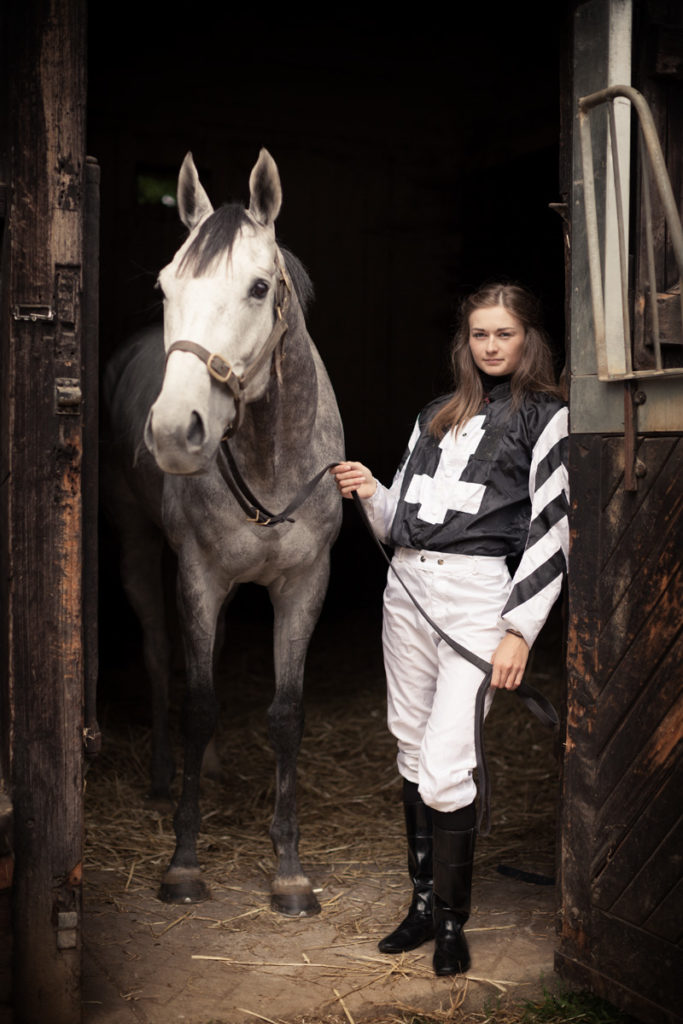
This was a commissioned shot for the regional tourist board Visit Suffolk. Rather than approach the advertising brief in a more traditional tourism way, we decided to highlight and feature prominent characters from the area. These are the people who make the region what it is, and form the very backbone of the county.
Shelly is an award-winning jockey, and the fact that she was also a young woman in a predominantly male world, made her character study even more unusual. I wanted to capture this glamour and pose her in the stables with her winning steed named ‘Silver’. Natural light was the only option that we had, as horses are predominantly timid animals that don’t like artificial flash. Luckily, natural daylight also suits the style of imagery that I prefer to shoot, and since artificial flash always looks so unnatural, we decided to work with what light we had. The overcast sky acted like a huge soft-box that diffused the quality of light, and by placing Shelly against the dark stable interior, I was able to almost spotlight my subjects. I chose a natural, relaxed pose that was informal and yet elegant, perfectly suited to the subject matter and emphasizing the close bond between them.
Waiter – The Great House Restaurant
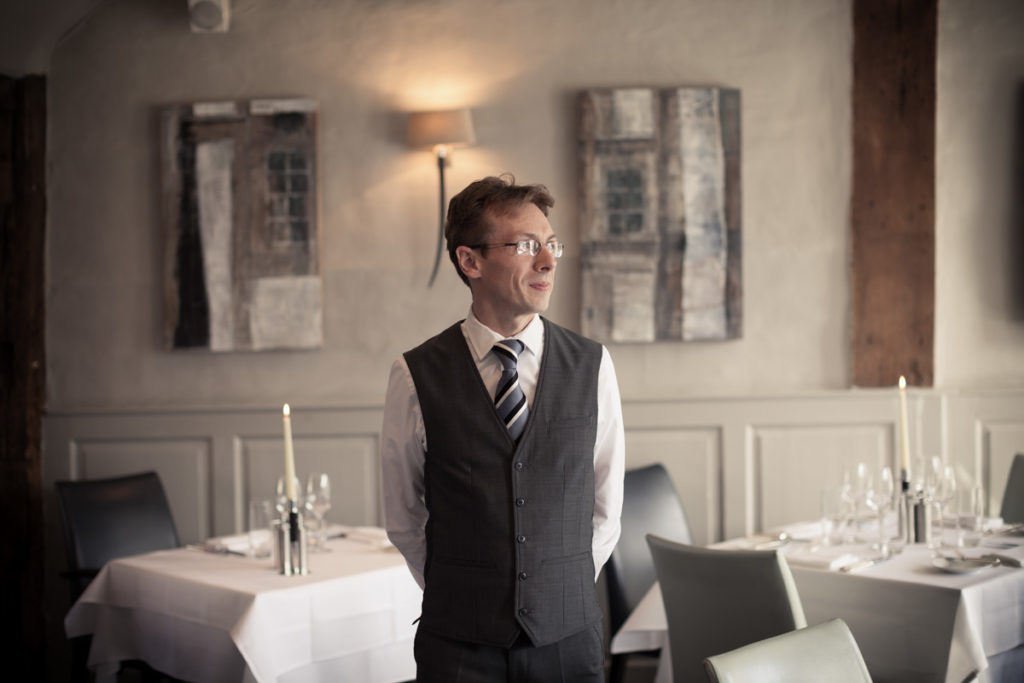
This image was shot for The Great House, an award-winning restaurant in the heart of old England that specializes in French cuisine. With a tight schedule, and with the doors soon to open for lunch, I only had a few minutes to pose my sitter and take the shot. Once again, I chose to use natural light that streamed in through the latticed windows on my right. Nowadays, digital cameras have a far wider dynamic range to traditional slide film from the past, so I didn’t need additional lighting to even out the contrast. I chose to have the waiter face the windows, evenly lighting his features whilst he expectantly waited for his first customer. Breaking eye contact also added to the tension in the shot, as the viewer wonders what the waiter is looking at, adding to the intrigue.
Bill Pinney – Orford Smoke House
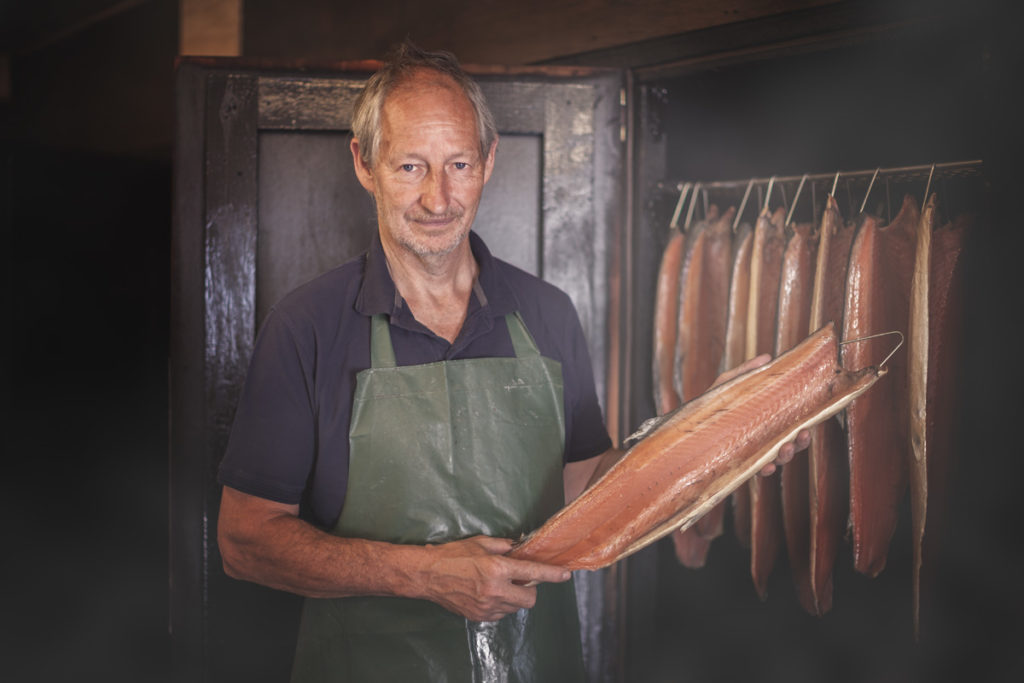
This wonderfully atmospheric environmental portrait captures both the character of the owner and the traditional charm of his old smoke house. The image tells the story of his family run business that is at the beating heart of this small village on the East Anglia coastline.
The shed looked and felt somewhat industrial, with large metal doors and ugly, fluorescent strip lights that ruined the ambient atmosphere I had envisaged. I wanted to portray Bill as a master craftsman, a man who had worked hard all his life to build a reputation for purveyors of the finest smoked salmon in Suffolk. He was the hero of this world, and I wanted him to look this way and transcribe this feeling into the finished image. I therefore turned off the stark, overhead lights and opened the shed door to stream in as much daylight as was possible. The open doors allowed the daylight to evenly illuminate his face and figure, at the same time adding small catch-lights to his eyes, bringing them to life. I also asked him to give a modest smile, that conveyed a warmth and trust in his product, without looking too contrived. Once again, the shallow depth of field, and carefully placed blur gives the photograph a distinct look that is an integral part of my environmental portrait style.
We tried several times to create an impression of real smoke billowing from the ovens, but there just wasn’t enough to show in the final images. Eventually, I decided to embrace technology and I carefully added the smoke in post-production, using Photoshop and a little digital wizardry.
Ted Tyrell – Transport Museum
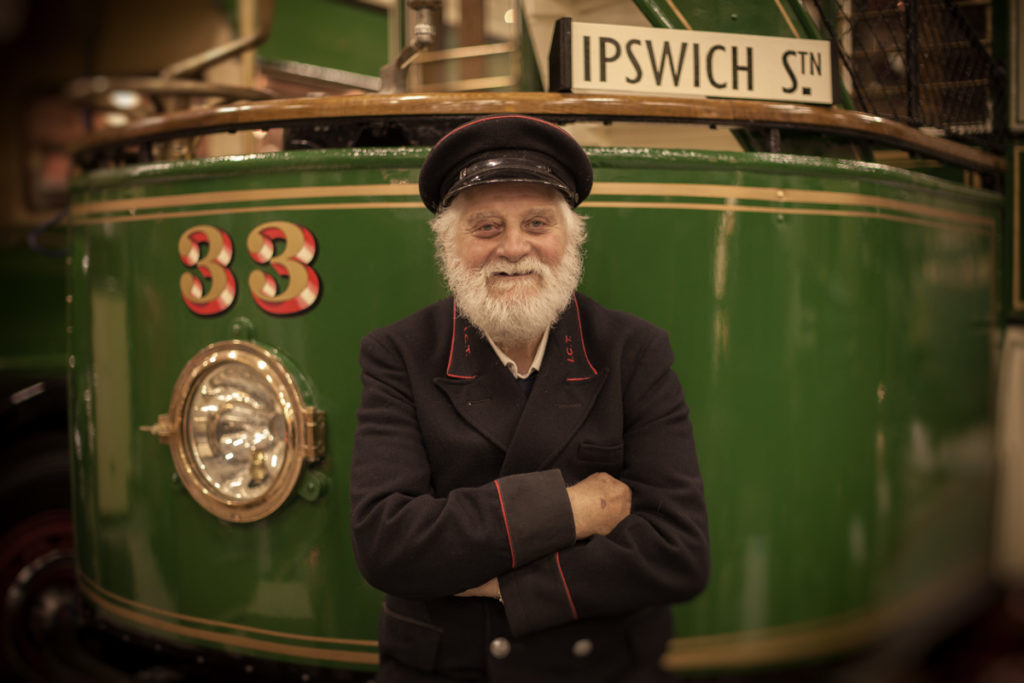
This shot was another commissioned image for a regional tourist board. Visit Suffolk had asked me to photograph some environmental portraits at the Transport Museum in Ipswich. I had great expectations of a charming, old garage, with lots of character and atmosphere. However, when I arrived, I was rather surprised, as it was far more practical and more like a large industrial hangar. With the original brief in mind, I needed to convey the romantic ideal of classic British motoring heritage, but I felt somewhat limited with my options. After a little thought, I decided to isolate this character standing against the green and brass exterior of a charming, old tram by shooting with a wide aperture on a fast 50mm f1.2 lens. When used wide open, the lens has a strong natural vignette and I utilised this optical characteristic to accentuate the subject, further isolating him against carefully chosen background elements. Working this way, I was able to suggest the story of the museum’s rich heritage, juxtaposed with a local character whose cheerful face welcomed visitors to come and explore.
Gordon Peacock – Yorkshire Dalesman
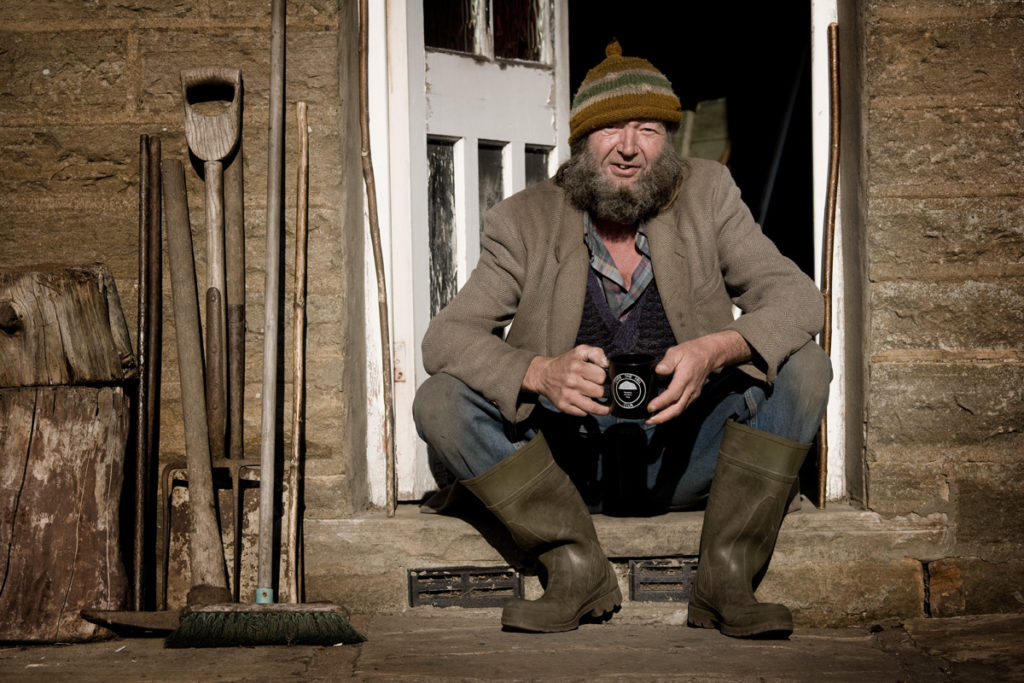
On this occasion, I had been commissioned by an advertising agency that was producing a promotional campaign for the Harrogate & Yorkshire Dales Tourist Board. They had asked me to shoot some iconic Yorkshire landscape images, and any interesting local characters that I met on my travels.
I love this type of work, as it gives me the freedom to be creative, and an opportunity to pursue my own personal style of imagery. With every person that I met, they all had their own unique characters that made them so fascinating to photograph. These ‘local heroes’ are not famous, and are by their own admission, nothing and nobody special. And yet their faces convey their personal history and a lifetime of stories they have to tell. They are almost carved out of the very clay that is the environment that has molded them.
Gordon Peacock was no exception. When I drove past him, he was standing outside his terraced cottage, deep within the Yorkshire Dales, propped up against the limestone wall, supping on a cup of tea and enjoying the early morning sunshine. I pulled the car over and sparked up a conversation. He had a deep, dulcet voice and a strong local accent that befitted his demeanour. I explained what I was doing, complimented him on his appearance and conversation ensued. Whilst I was talking to him, I was also trying to envisage how and where I would pose him, what lens I would use and how I’d be able to capture his persona and spirit.
Since people become bored quickly, I needed to relax my subject and find out a little about him so I could portray his character appropriately. “So you’re a true Yorkshire man born and bred eh?” I asked. “Aye!” he replied in a broad accent. “Lived here in this cottage all your life, have you?” I tried again to ignite further conversation. “Aye…tha’ Dales is ma’ home, always ‘as bin an always will be” he said. “So, what …you’ve lived in this one cottage all your life, have you?” I asked. “Oh naaaaay! “ he said, “I’ve moved about quite a bit.” “Oh, where else have you lived then?” I asked. His reply came back: “I used to live in the cottage next door!” No wonder this man had such local charm – he was the embodiment of the Yorkshire Dales and a true product of his own native environment.
Peter Henfrey – Dales Sheep Farmer

Another serendipitous character study, this time shot for the Yorkshire Tourist Board. Since the image had not been planned, it took a great deal of persuasion to charm Peter in to having his photograph taken. Personally, I shy away from having my own photograph taken, so this enables me to fully empathise with my reluctant sitters. After several minutes of conversation and a wealth of compliments, my sitter finally acquiesced to a few shots but for some reason refused to look into the lens. Nevertheless, this happened to work in my favour, as I was able to emphasise his wooly side-burns, which seemed rather appropriate for a Dales sheep farmer. By allowing my subject to break eye contact, he remained aloof and distant whilst I was able to convey an intimate, but less personal character study of him. The lower viewpoint simplified the busy background and the soft, hazy light yielded a beautiful, yet natural portrait that spoke of the Dales, but without the need for any words.
Robert – Shepherd & His Border Collie ‘Fletch’.
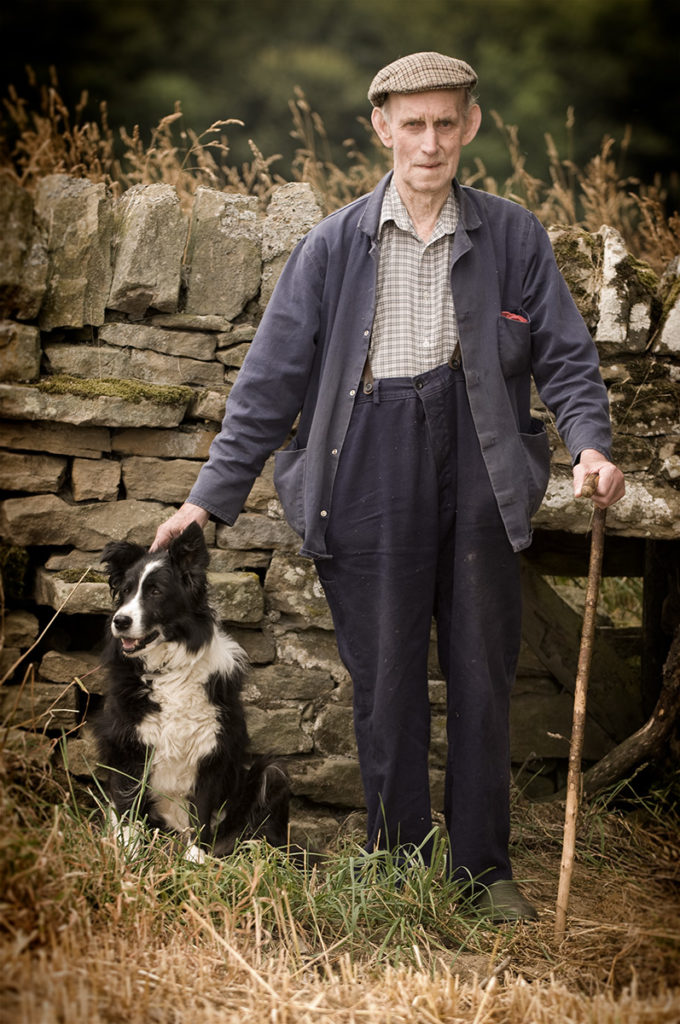
This environmental portrait was taken whilst I was on a commission for Visit Britain (formerly The British Tourist Board). It was shot upon the rolling hills of Northumberland, not far from Hadrian’s Wall. Like a hawk searching for its prey, I spotted this lonely figure and his sheepdog walking in silhouette on the horizon, about half a mile away from the roadside. Over the years my eyes have become trained to recognise photo opportunities like this from afar. I pulled the car over and I flew across the fields to take a closer look and to introduce myself to them both.
A good environmental portrait includes just enough detail from the location to convey more about your subject and their life, without being too distracting. The ‘environment’ strengthens to the overall message that the image portrays, and helps to focus on the story you are trying to tell. By photographing Robert in his natural environment I was able to portray his character, life and his personality – rather than just a physical likeness. I like to believe that every element in my photographs has value and strengthens the narrative told. This character’s clothing and attire also tells the story, and had I employed a professional stylist, I doubt we could have dressed him or chosen the props more appropriately.
Eric Edwards – Reedcutter.
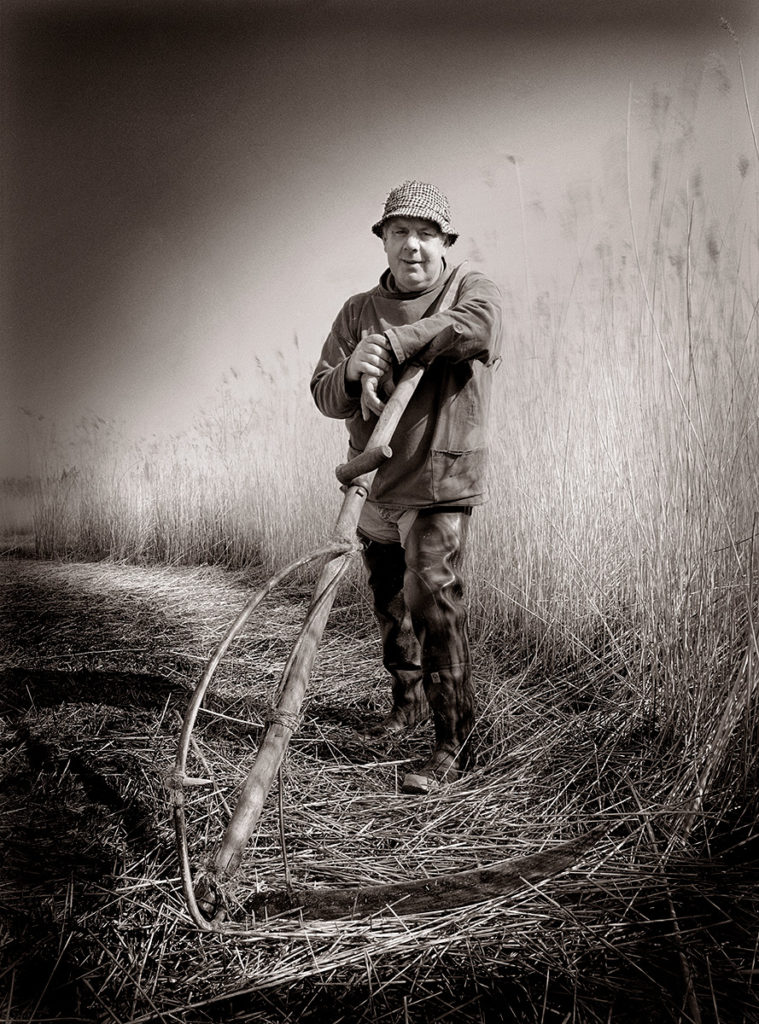
Shot on a cold, February morning in the Norfolk Broads, I hope that this image captures the spirit of a traditional craftsman in place. The face of the common working man often shows real character, and their life story can be read within the lines and wrinkles on their face. I love local heroes like these … far more interesting to photograph than the rich and famous.
Eric had worked for the Broad’s Authority for many years, and was no stranger to this part of the world. I chose to shoot with a wide-angle lens, so I would be able to accentuate the importance of his scythe. Each cutting season, he carved this tool by hand from ‘loocal’ yew, a pliable wood that was also traditionally used in longbows. I chose to shoot from a low perspective to accentuate the dominance of the subject against the simple, sweeping background of marsh reeds.
Mamiya 645 Pro, Kodak Alaris TMax 100 film, 45mm wide-angle lens. Once again, I preferred to over expose the film for additional detail in the shadows. This made it necessary to pull development time by a few minutes to hold highlight detail better. I burned a heavy, black vignette around the edges of the image, to spotlight the subject and add depth and atmosphere to the image. Originally printed in my darkroom on Agra Record Rapid grade 2 fibre based paper, and toned in a shallow bath of selenium at 1:10 concentration to give the image its warm tones, to strengthen the blacks and to enhance archival permanence.
Eric Holmes – Deep Sea Fisherman.
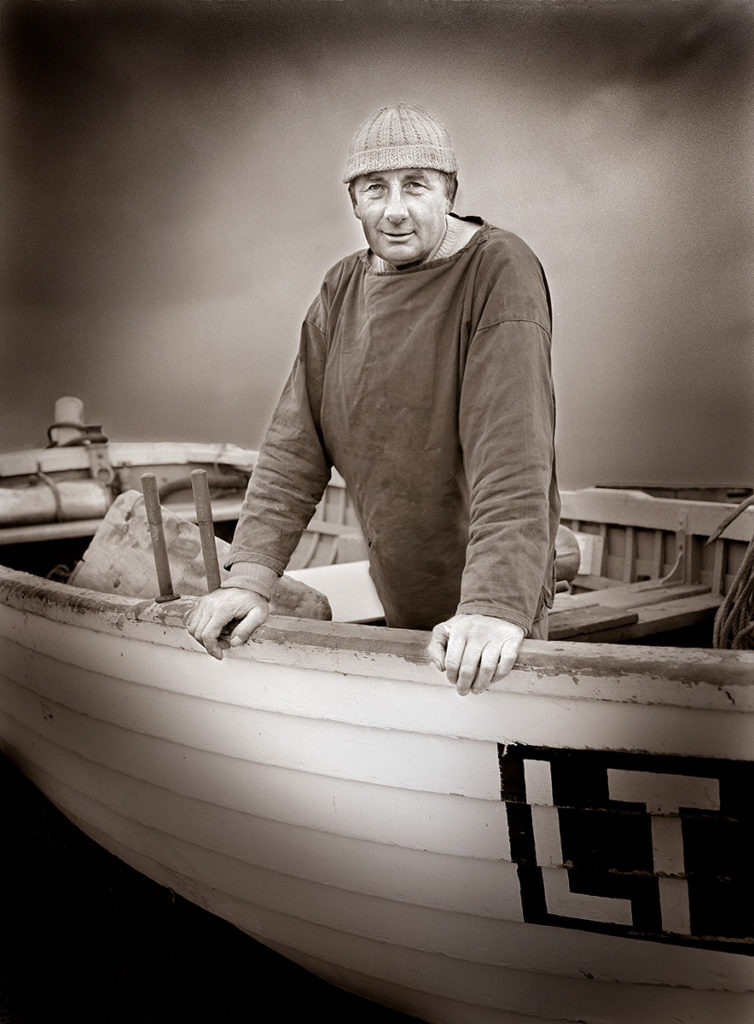
I’ve always had great admiration for traditional sea fishermen. It’s not an easy job, it’s not well paid, and every day they chance their lives against the unpredictable and capricious will of the sea. This fisherman’s face has been carved from many years of hard work and his exposure to the harsh, natural elements. His weathered features show tenacity, bravery and yet a warm human side to his nature, and I wanted to capture this in his portrait. I chose to shoot using traditional monochrome film, as I felt the black and white tones would strip down the noise and distraction of colour elements. For me, black and white photographic portraits have a certain simplicity that cannot be captured nor expressed with colour film.
Since environmental portraits also include the location of your subject, they often demand a slightly different technical approach. Whilst traditional portraits are usually close crops with long lenses that give shallow depths of field to blur much of your background, environmental portraits are a little different. Conversely, environmental portraits include the all-important background and therefore give more information to strengthen your visual message. Environmental portraits are therefore often shot with wider lenses with greater depth of field than more conventional portraits. By including some of your subject’s background and location, a good photographer can utilize the surroundings to give his image substance, meaning and strengthen the visual narrative.
Shot on traditional film using a Mamiya 645 Pro, Kodak Alaris TMax 100 rated at 50asa and developed by hand in TMax developer. I chose to over expose slightly for extra shadow detail and then pull (shorten) the development time to reduce the contrast and hold highlight (sky) detail better.
Nib – Fenland Tractor Breaker.
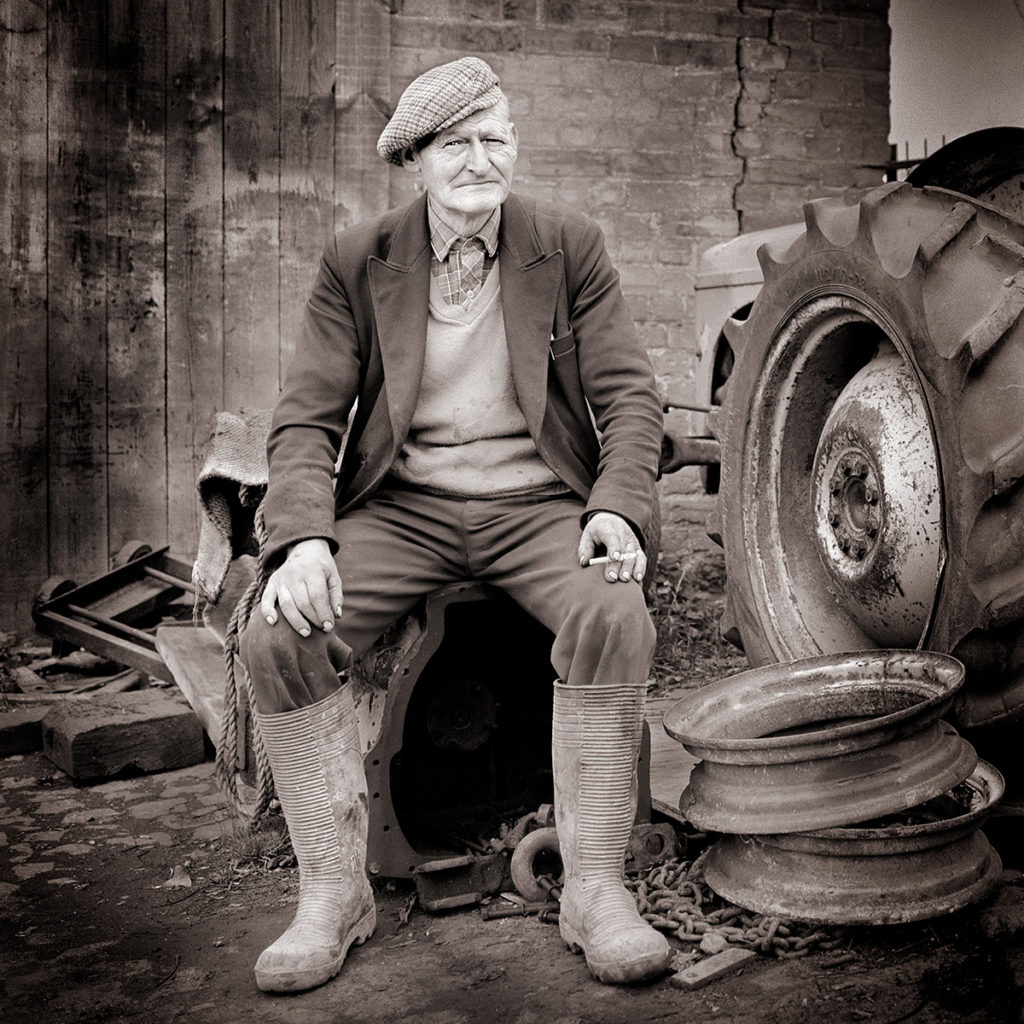
Another ‘local hero’ whose face speaks one thousand stories more eloquently than words. Scouting and exploring new locations is always exciting, as you never know just what’s around the next corner. This environmental portrait was shot whilst I was driving around the Fens, searching for interesting landscapes for my personal portfolio. I came across an old tractor breakers yard, near Gedney Dyke in Lincolnshire. After a short nose around, this old guy enquired as to my intentions. As soon as I saw his face, I recognized his potential as a portrait subject and ignited friendly conversation. At first, this old guy was reluctant to be photographed, and couldn’t quite understand why I would want to take his picture. He was a real “looocal bor” (as we say in Norfolk) and I think he was worried I was from the Inland Revenue!
At first I went in for a closer shot with my medium format film camera and 80mm standard lens, but it felt too restrictive and failed to tell the story of the location. I therefore decided to adopt a slightly wider 55mm lens that would also take in some of the surroundings. As you can see, the location and backdrop are almost as important as the sitter himself, and a close up view would have had a very different feel. When I asked him his name, he replied “People just call me Nib.” A few moments later I knew the moment had been captured for posterity, and my portfolio was one more timeless image richer.
Some of these images are taken from my international, best selling book published by FW Media “Photographing People Like A Pro”.